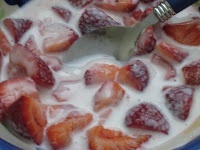 Generally, I'm not a fan of creme brulee as it divides my attention from true dessert: chocolate. But, I find that perhaps I need to adopt a more sophisticated approach to dessert and allow for all types, including custards, bread puddings, fruit tarts, and so on. In truth, I never stray from a decadent chocolate cake or fudgy brownie when I peruse any dessert menu, but I am slowly beginning to appreciate dessert in another medium.
Generally, I'm not a fan of creme brulee as it divides my attention from true dessert: chocolate. But, I find that perhaps I need to adopt a more sophisticated approach to dessert and allow for all types, including custards, bread puddings, fruit tarts, and so on. In truth, I never stray from a decadent chocolate cake or fudgy brownie when I peruse any dessert menu, but I am slowly beginning to appreciate dessert in another medium.That is why I'm posting this recipe. Not only did I once believe that creme brulee was a fancy word for 'not chocolate', I also didn't think it was anything special. Yet, I found myself positively enjoying this wonderful custard with the burnt sugar on top. I hope you will too.
Creme Brulee
2 cups heavy cream
1 teaspoon vanilla extract
3 egg yolks
pinch of salt
1/4 cup sugar
4 tablespoons fine sugar
Preheat oven to 300F. Have a pot of boiling water ready. Add the cream to a heavy saucepan over medium-low heat. Warm the cream until bubbles start to form around the edges of the pan and steam begins to rise from the surface. Remove from the heat, add the vanilla extract, and set aside to steep, about 15 minutes.
 In a large bowl, whisk together the egg yolks, salt and the 1/4 cup sugar until smooth and blended. Gradually add the cream to the egg mixture, whisking until blended. Pour the custard through a fine-mesh sieve set over a bowl. Divide the custard among four 5- or 6-oz. ramekins and place the ramekins in a baking pan. Add boiling water to fill the pan halfway up the sides of the ramekins. Cover the pan loosely with aluminum foil and bake until the custard is just set around the edges, 35 to 40 minutes.
In a large bowl, whisk together the egg yolks, salt and the 1/4 cup sugar until smooth and blended. Gradually add the cream to the egg mixture, whisking until blended. Pour the custard through a fine-mesh sieve set over a bowl. Divide the custard among four 5- or 6-oz. ramekins and place the ramekins in a baking pan. Add boiling water to fill the pan halfway up the sides of the ramekins. Cover the pan loosely with aluminum foil and bake until the custard is just set around the edges, 35 to 40 minutes. Transfer the ramekins to a wire rack and let cool to room temperature. Cover with plastic wrap and refrigerate for at least 4 hours or up to 3 days.
Transfer the ramekins to a wire rack and let cool to room temperature. Cover with plastic wrap and refrigerate for at least 4 hours or up to 3 days.Just before serving, sprinkle 1 Tbs. of the sugar evenly over each custard. Using a kitchen torch, melt the sugar. Serve immediately.






